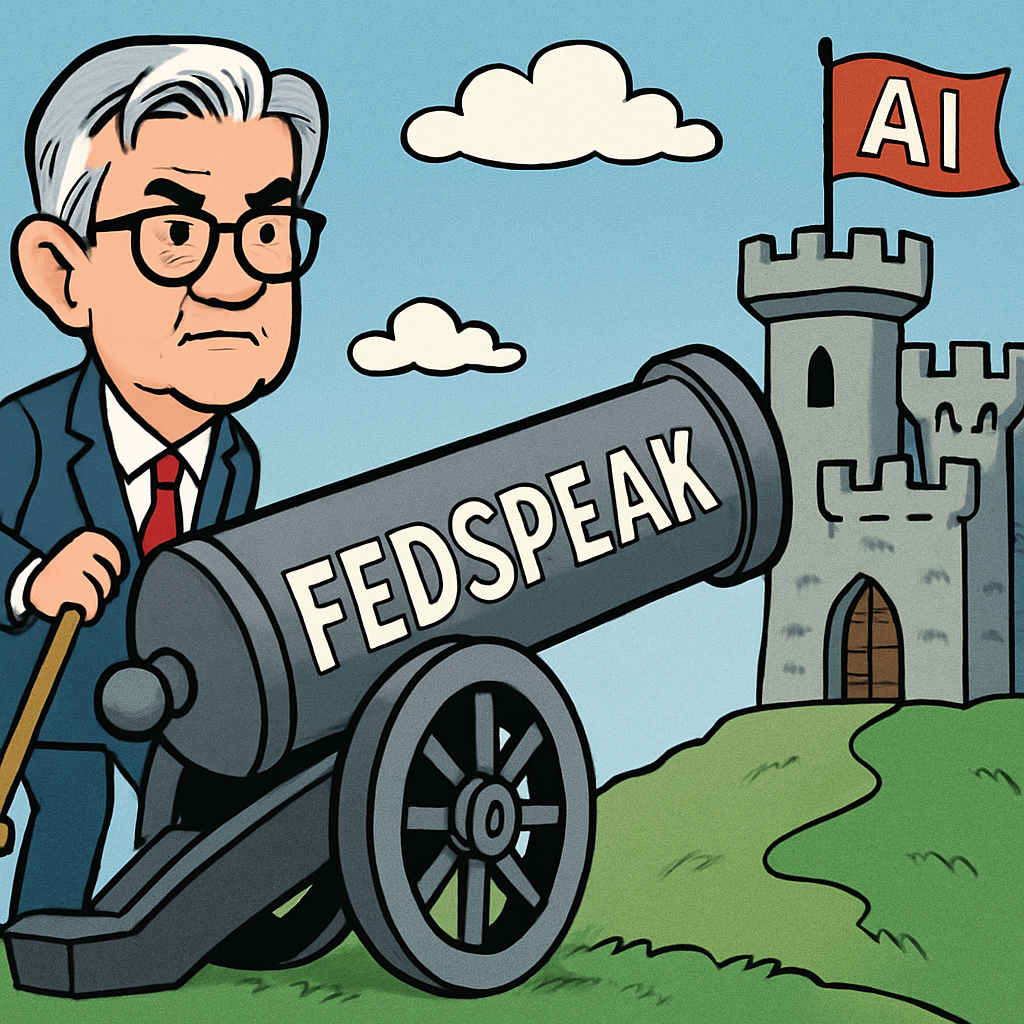
Why sentiment, not fundamentals, drove this week’s selloff–and what investors should really focus on.
KEY TAKEAWAYS
-
The Fed’s tone shift and collapsing rate-cut odds triggered a marketwide sentiment break
-
The VIX stayed elevated, signaling real fear, not a one-day spike
-
NVIDIA and the AI complex sold off despite stellar earnings
-
Valuations are elevated but not extreme relative to growth
-
Overall selling was driven by sentiment, not fundamentals
MY HOT TAKES
-
Investors are reacting to tone, not data
-
Fear overwhelmed fundamentals in a textbook sentiment shock
-
The market is mispricing world-class earnings
-
Volatility finally found its footing after months of complacency
-
The long-term thesis hasn’t changed–only investor nerves have
-
You can quote me: “This wasn’t a valuation correction; it was a sentiment malfunction.”
Volleyed and thundered. Lord Tennyson’s The Charge of the Light Brigade seems apt after the past week in markets.
Cannon to the right of them,
Cannon to the left of them,
Cannon in front of them,
Volleyed and thundered…
Are your ears ringing as well? What will be left of our once-impenetrable brigade when the cannon smoke clears? Will it ever clear? You have questions, and I understand that. To be clear, you are not alone. If you looked up at the financial news cable channels you would have seen a steady stream of “I told you so” guests, which probably did not help ease any of your discomfort with what seemed like irrational selling in the wake of what would be considered by any traditional–or even non-traditional-metrics for corporate health. So, what the hell is going on then?
In my typical way, I would like to provide you with information, so that you can come to your own conclusions on what happens next. I will show you what happened in 4 charts. Here we go–glasses up.

I submit to you, chart 1 which shows possibly the largest single sentiment driver in the past few weeks. That’s right, it’s the Fed and what it might do next month. Though it shouldn’t be front and center on this issue, it is. Does a 25 basis-point cut in December or January really have anything to do with how well NVIDIA or Meta is going to perform over the next 5 years. Please tell me you answered with a quick “no!” But, alas, investors have gotten their minds so wrapped up in FOMC policy, that it has distorted many investors’ ability to make reasonable, facts-based decisions. Frankly, the markets have become addicted to Fed rate cuts. Don’t worry, I know the financial math behind how interest rates impact valuations, but trust me, the 25 basis-point difference in no way affects the bull case for many of the recently beaten-down tech megacaps–trust me.
The chart above shows the probability of a December rate cut based on Fed Funds futures. You can see how it was almost at 100% leading up to Powell’s last post-FOMC presser, and how it declined in the wake of his “it’s not a given” statement. Though it bounced around in the mid-60s for a few weeks, those are still considered good odds on Wall Street. Clearly, that wouldn’t last as the probability slipped below 50% last Friday and decreased yet further with this past week’s FOMC meeting minutes release. If I had to guess what happens next based on this number… well, the prospects for a cut are not great.
I promised you 4 charts, but I can’t help myself and have to give you a 5th bonus chart. Anna Wong, Bloomberg’s Chief US Economist and some of her colleagues published an interesting working paper on the creation of a Fedspeak index, which I find to be not only interesting, but I find the index itself quite useful (thank you Anna, it has been added to my Zotero 😉). Check it out and keep reading. Oh, and please reach out if you want the article (Anna Wong, Nick Hallmark, and Ana Galvao. Bloomberg Economics Fedspeak:Towards a High Frequency Fed Sentiment Index).

On this chart, you can clearly see a shift in Fedspeak sentiment from dovish to hawkish in recent weeks, and this has been a clear catalyst for the selling! Now let’s move on to the next chart, which is, in my opinion, the emotional heartbeat of this entire week. Have a look and keep reading.

You don’t need a doctorate in finance to see what is happening in that chart. Volatility has not only risen, it has stayed elevated, a clear sign that investors are no longer shrugging off risk the way they did all year. There was a quiet, comfortable complacency from late summer through early fall, a feeling that no matter what the Fed said or what geopolitical mess suddenly appeared on the screen, the market would just keep grinding higher. But this week that changed. The VIX didn’t just flash higher, it marched higher, plateaued, and then rose again. When volatility stays sticky like this, it tells you that investors are now pricing in the possibility of more downside. In short, fear finally came home to roost, and it’s not leaving the porch just yet.
Which brings me to the next chart, and it’s one that you’ve all seen in real time because it played out live yesterday. Have a look and keep reading.

Look at that chart and tell me with a straight face that markets are behaving rationally. NVIDIA posted yet another blowout quarter–one that, by any historical standard, should have lifted the entire tech complex. Instead, the market sold off. Did I mention that all the AI mega caps also announced big wins a few weeks back? Yesterday’s move wasn’t just a gentle drift lower, it was a synchronized, almost panicked broad-based unwind. NVIDIA is still up massively year to date, still dominates AI compute, and still enjoys demand most companies can only dream about. Yet the entire AI space fell under its own weight because the broader macro mood soured. This is what I mean when I say sentiment, particularly Fed-driven sentiment, is overwhelming fundamentals. When fear takes the wheel, even the best earnings in the world can’t effectively steer the car.
And now for the final chart, which addresses the question I know many of you have been thinking even if you haven’t said it out loud. Check it out and follow me to the close.

This chart shows forward P/E multiples from the Mag-7 (red line) and the S&P 500 (white line) over the past year. Are valuations really that stretched? Is AI really that expensive? Well, the chart tells you the truth—yes… well, kind of. The Mag-7 forward P/E is elevated relative to the S&P 500, but not in a way that is historically absurd. In fact, the premium has been wider at times this same year. Moreover, the S&P’s own forward multiple hasn’t exploded upward; it’s drifted higher gradually as earnings have grown. What this means in plain English is that valuation panic is a narrative, not a data point. Investors are treating 30x forward earnings as if it’s some catastrophic red flag, ignoring the companies behind those multiples–companies that are growing earnings 20-40% YoY in some cases. NVIDIA just announced a 60.5% year over year EPS growth! The real stretch isn’t the multiple, it’s the psychological tolerance of investors who’ve seemed to have forgotten what rapid secular growth actually looks like.
Now, I promised you four charts, I gave you five, and the reality is that all are symptoms of an even bigger driver: sentiment deterioration coupled with Fed uncertainty. The combination of Powell’s recent tone shift, falling odds of a December cut, and the near-universal obsession with “what the Fed will do next” have created a pressure chamber. When you overlay that with sticky volatility and a market that suddenly refuses to reward great earnings, you end up with exactly the week we just lived through.
These charts, sentiment, volatility, leadership divergence, valuation spreads, are the near-term cannon blasts hitting the market from all sides. None of them, individually, justify a structural change in the long-term thesis for AI, for tech, or for equity markets more broadly. But together, over a very short time window, they create confusion, discomfort, and noise. A lot of noise! And here’s the thing… investors hate noise. They crave certainty, and the market simply cannot deliver that right now. When Powell shifts tone, when futures reprice, when volatility holds its ground, and when NVIDIA doesn’t get rewarded for smashing earnings… well, that’s exactly when even seasoned investors start hearing Tennyson’s cannons again.
Cannon to the right of them,
Cannon to the left of them,
Cannon in front of them…
Volleyed and thundered indeed.
So, the question, perhaps the quiet, cautious one that everyone is thinking, is this: Do these near-term drivers warrant a longer-term pullback? I’m not going to answer that for you directly. You know my feelings about long-term thesis investing. But I will tell you this: the facts matter, emotions don’t, and your job as an investor is to stay focused, stay informed, and keep collecting data rather than reacting to fear. The cannons may be loud right now, but the smoke always clears. The real question is what you choose to do while visibility is low.
YESTERDAY
Stocks sold off yesterday in the wake of great earnings from NVIDIA the night before. Early gains could not be held as the BEA released a delayed report from September which showed greater jobs growth than expected. The completely dissolved “Fed Put" left nervous investors seeking the exits.

NEXT UP
-
S&P Global US Flash Manufacturing PMI (November) is expected to have slipped to 52.0 from 52.5.
-
S&P Global US Flash Services PMI (November) may have eased to 54.6 from 54.8.
-
Housing Starts (September) are expected to have climbed by 1.7%.
-
Building Permits (September) probably increased by 1.3%.
-
Next week, believe it or not, we will still get some important earnings, in addition to more housing numbers, Producer Price Index / PPI, Consumer Confidence, durable goods orders–all before Thanksgiving. Don’t be a turkey–show up on Monday and download weekly calendars to avoid getting fowl’ed up. 🦃
.png)

